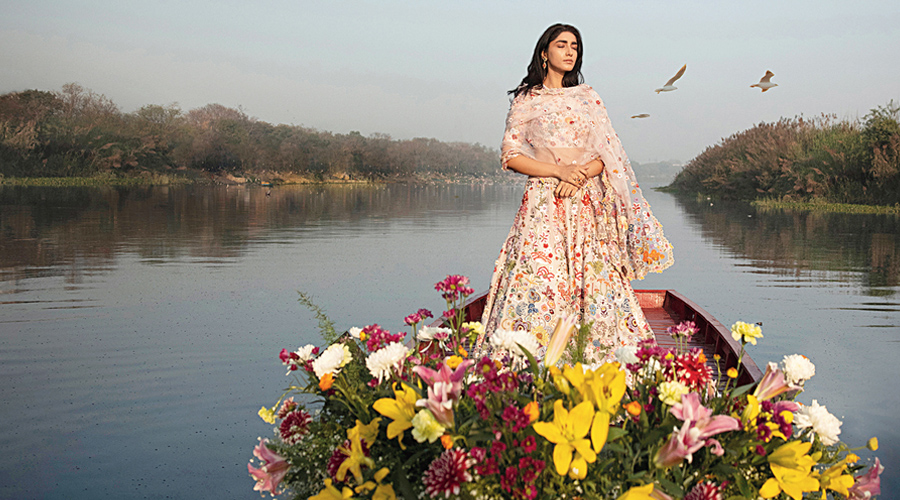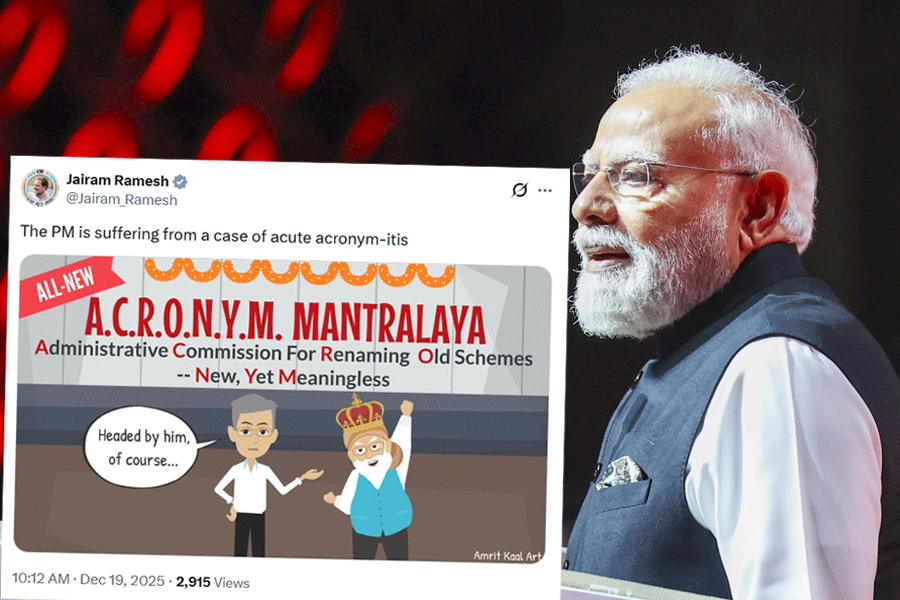When Dia Mirza struck a pose in a beautiful red sari complemented by a floral bun, statement jewellery and that bright smile of hers at her February wedding, she set the tone for a pandemic bride. Understated and graceful. “It was a very intimate wedding and 99 per cent of our guests were local and the decor was completely natural with locally sourced flowers. We did it in our garden at the back of the building where I spend every morning of my life listening to bird songs. The food was also catered with specific instructions. We knew exactly who ate what and the kind of quantities, so we had no waste,” Dia recently said at a Ladies Study Group chat.
A sentiment most brides and grooms-to-be share, with this pandemic not showing signs of bowing out of our lives anytime soon. Close-knit, classic and simple are what weddings are looking like these days for those who are choosing not to delay in ushering in the D-Day of their lives. If ‘intimate’ was niche earlier, it is the only reality right now, for generations brought up on the romantic and colourful albums of Hindi films like Hum Aapke Hain Koun..! and Dilwale Dulhania Le Jayenge.
The Telegraph caught up with a bunch of designers and service providers, all part of Vogue India’s Vogue Wedding Show 2021, a special virtual edition of the luxury wedding exhibition, on till June 30, to get a feel of the pulse of the great Indian wedding in 2021. Read on.

From “handcrafted” bandhgalas to kurtas to “bespoke looks”, Raghavendra Rathore is for the classic man
Intimate affair
Tarun Tahiliani: The grandeur has been reduced, the gatherings are intimate, the clothes will be lighter and/or upcycled from mother or grandmother’s wardrobe. So the format in which we are headed in terms of wedding trousseau is very sustainable at its core. The consumption for occasionwear will not only witness a decline, but we are also prepared that some may not consume at all after being shaken so heavily by this global crisis. And there is nothing that you can do about it. While marriages will continue to take place and the immediate family still may want to look good along with the bride and the groom, people will not be wearing the kind of clothes they used to, which will affect the way we produce. As for the brides and grooms, since they will not be on a stage, everything will be looked at and appreciated from much closer, either by an intimate crowd or virtually on Zoom calls, which in turn dials up the need for intricate, good quality and beautiful ensembles.
Rahul Mishra: While the country continues its fight against the pandemic, sentiments are understandably low. Large gatherings remain to be a distant idea and weddings are still preferred intimate. People desire hope and festivities, however small, shine a ray of positivity.
Raghavendra Rathore: Simplicity, subtle aesthetics, smaller functions are the things people are gravitating to, understandably. It will no doubt have a lasting impact on how designers plan and execute their collection and products. The tone is set for more classic, elegant and personalised designs.
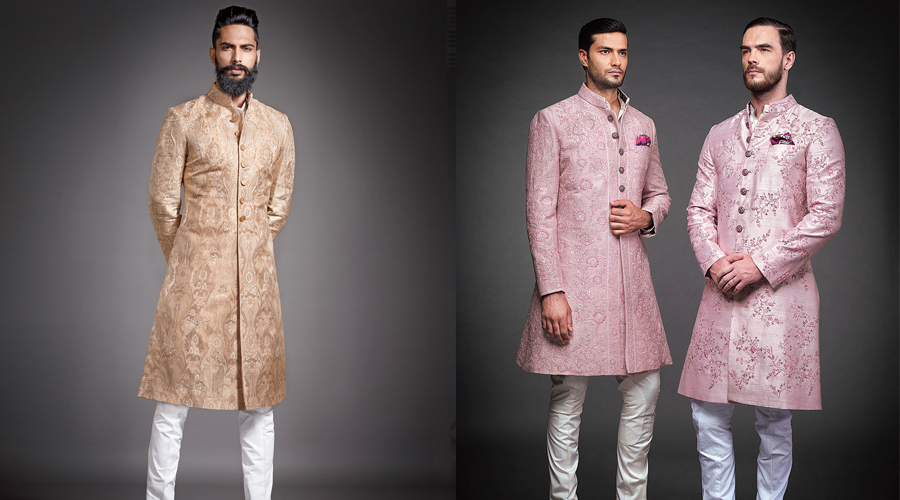
From “handcrafted” bandhgalas to kurtas to “bespoke looks”, Raghavendra Rathore is for the classic man
Mindful consumption
Tarun: As awful as it may sound, the pandemic gave us something that I think we all had lost — time. And, I can speak for myself here because it forced me to stay in the same house for over six months, and it gave me time; it allowed stillness. I have never done that, and therefore, as a consequence of it, I had a lot of time to think, evaluate, and reassess, much like most of us. And, all this has affected my fashion direction at many levels because the focus is now on what we need, how can we honour the planet. There will be many fundamental shifts in our behaviour, in how we consume… which will reflect in the quality of what we pick and how we shop.
It’s also funny how the pandemic has taken some weight off of the brides. They are no longer under the pressure of a red-carpet-like look or having to worry about being noticed by 3,000 people in a stadium. They can now just pause and be themselves, much like how it should have been, anyway.
The focus has shifted heavily on the quality of work, how a person feels with the fit of her garment and having a more significant, liberal say on the colour palette. Because, once you understand how incredible an outfit has made you feel, it is then that you find multiple ways to use and reuse it.
Rahul: Due to the pandemic, people have an elevated sensibility towards human emotion, craft and longevity of their garments. They are consciously willing to invest in fashion that tells their story, supports local crafts and lasts in their wardrobe for years to come. It is about sustainable, mindful luxury that benefits local craft and is sensitive to the planet while being beautiful to look at.
Rathore: Customisation and smaller functions have set a new road map for weddings during these times. Products need to be more personalised and value needs to be an inherent part of the groom’s wardrobe, with the ability for him to wear these clothes more than once.
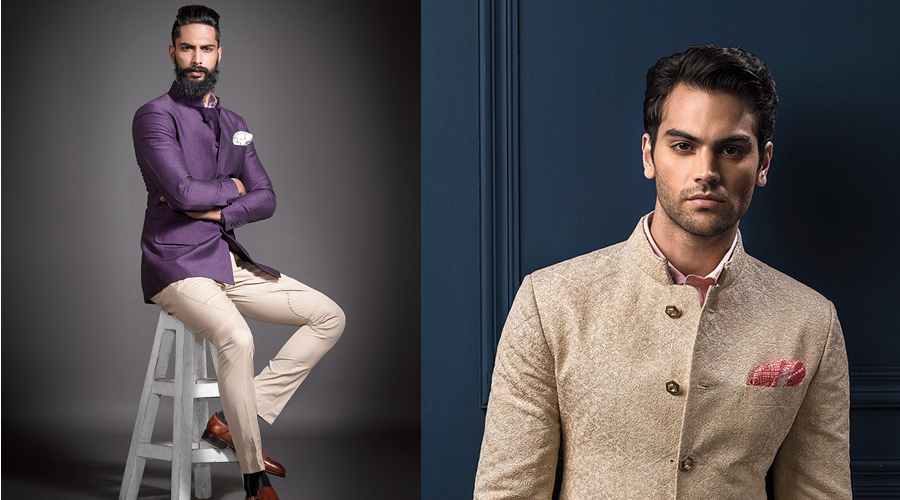
From “handcrafted” bandhgalas to kurtas to “bespoke looks”, Raghavendra Rathore is for the classic man
Bespoke and timeless
Tarun: I think for the past few years, we have seen collections become more and more seasonless. In India primarily, couture has always been centred around weddings, and bridals usually have two strong trends that have been prevalent over time. One is the traditional reds, and the other is soft pastel hues. With the second wave of the pandemic, however, we will see lesser importance on season-based collections. As a brand, we have always believed in timeless and classic silhouettes that have more longevity.
Rahul: As we progress towards mindful luxury and slow fashion alternatives, craftsmanship is beginning to emerge as a new factor that determines the value of a garment. More people are interested in knowing where their clothes are made and if it represents their values of conscious living and thoughtful consumption.
Rathore: It is best not to chase trends but stay focused on personalised bespoke design, be it jewellery, accessories or apparel. Clothing that is intrinsically classic goes a long way and has always proven to be a great reference point for decades. Even if you go back in history some of the best styles worn had the purpose and appeal that is unmatched.
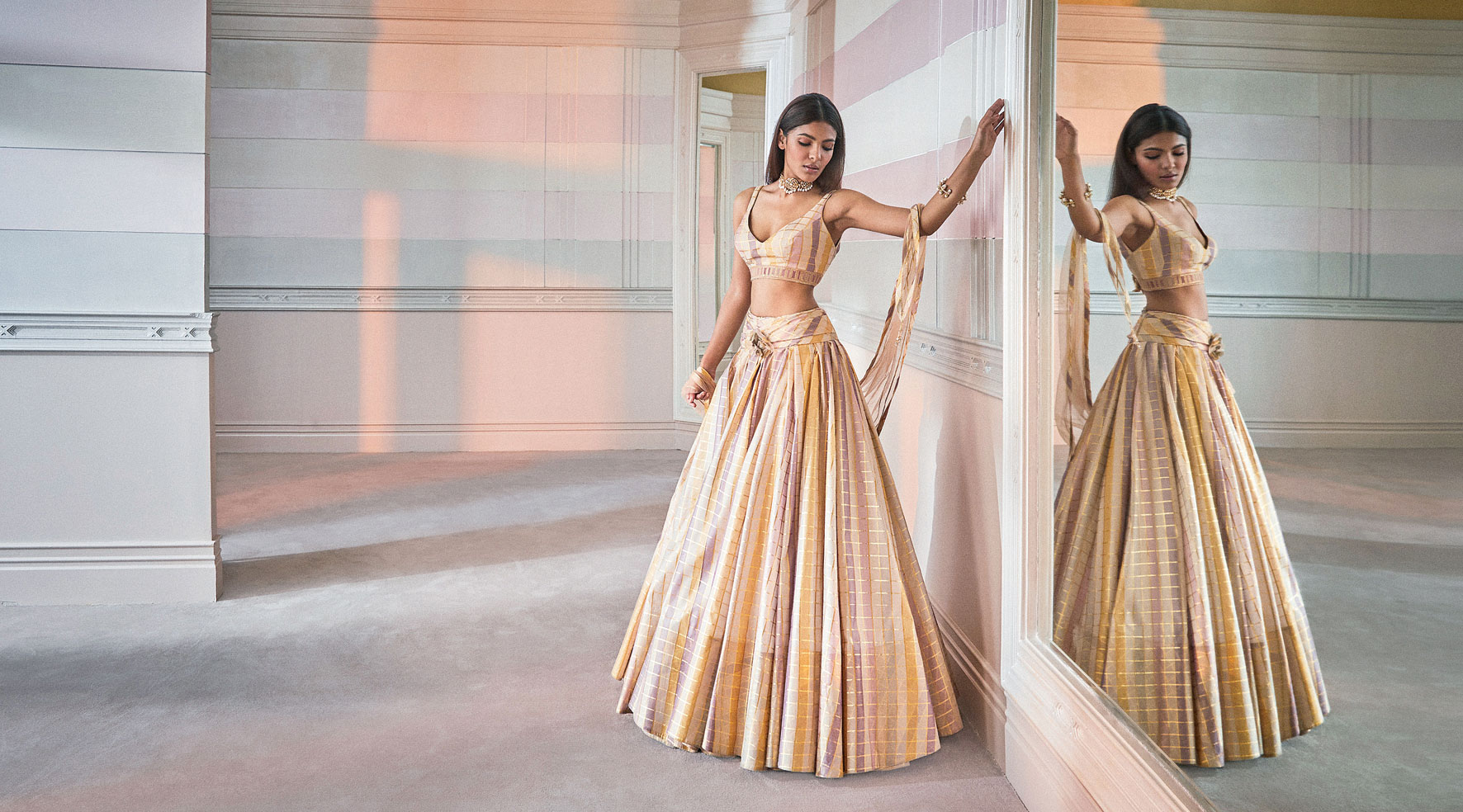
Indian bridals are as much about reds as “soft pastel hues”, says Tarun
Evergreen trends
Tarun: Wearing beautiful, high quality and something she will cherish forever is the only trend that will never change for any bride.
Rahul: A mother’s wedding outfit or grandmother’s jewellery will always be significant to a bride. It is craft, culture and a personal story that holds relevance for people. Referencing tradition in their way of individual expression, brides are learning to invest in clothing that focuses on comfort, versatility, quality and craftsmanship, instead of just the looks.
Rathore: Classic looks in beige colour... the timeless nature of subtlety, whether through embroidery or accents as trims work really well. Also investing in heirloom buttons that can be passed down for generations may be the resurrecting trend. The signature RR bandhgala and achkan are two silhouette examples that will never go out of style. While the colour palette for a groom’s wardrobe can be diverse and have a beautiful mix of pastel and jewel tones, it is safe to say that colours like ecru, cream and gold tones are ideal as they complement beautifully with the vibrant colours that the bride would ideally adorn.
Individual expressions
Rahul: For weddings I believe, individual expression is becoming an important part of a bride’s experience. While she is traditionally rooted, she is her own person and she wants to make that evident. Hence we are seeing a range of hues ranging from the quintessential red, pink and peach to mint green, ice blue, metallics and even shades of ivory. As for silhouettes, brides are experimental and practical. Some of them may be choosing to replace a traditional dupatta and blouse with a cape or tailored jacket, while some of them find comfort in a long cascading veil. While the basic silhouette of a sari or a lehnga skirt may remain classic, there’s innovation in how it is approached. The possibilities are endless if we allow them to dream.
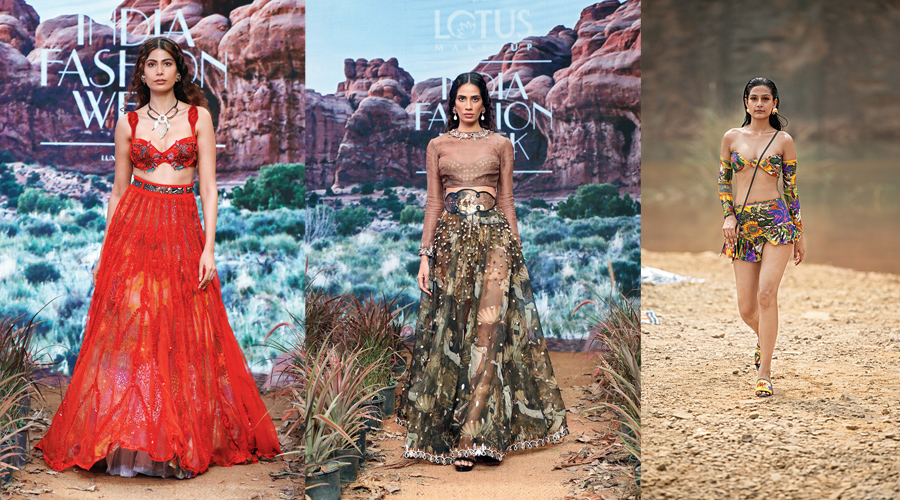
Shivan & Narresh’s destination wedding and honeymoon lines are for the body proud with a strong vein of “self-love”
New silhouettes and colours
Tarun: All our collections are designed keeping in mind both traditional as well as newer trends. Our latest bridal collection is a reflection of this. Persian jaali in monuments has always been of great inspiration to me, and I love to find ways to incorporate it into my design work. This season I have used laser-cut jaalis in three-four tones on light silk, accentuated with kasab and kundan and the use of precisely-cut gota, not only to ensure the sumptuousness of these techniques but also to maintain lightness in the final garment.
Using playful pastels and metallics, and reds, the ‘Timeless’ collection is full of hand-embroidered pieces. The traditional red lehngas have a fine tulle base with silks and bandhni adorned with the use of kundan with handloom textures in intricate Benarasi brocades. For the day wedding and other functions, we’ve presented a fun range of pastels and metallics. The silhouettes that make up the collection include lightweight lehngas, shararas, peplum blouses, concept saris, newly structured drapes and Anarkalis. Using a unique fusion of ari and kasab and chikan on our signature, hand-painted prints, there is an infusion of handlooms such as Chanderi squares and stripes and unique Kanjeevaram weaves along with bandhni.
Rahul: Today’s brides are significantly aware of international fashion and have evolved sensibilities when it comes to the cut and tailoring. There is a rise in the number of women preferring to wear couture gowns and floor-length dresses. These include body-fitted silhouettes to the more flamboyant flared shapes. Unusual but delicate hues of blue, lilac and even grey seem to have found their way into bridal fashion.
Rathore: Pastel tones and neutral colour palettes are best suited. The key to a successful wedding collection every season is to stay true to your vision and the look one is best known for and find a way to redefine it with the play of accessories, treatments
and colour combinations.
The great Indian wedding
Rahul: Festivities are the pulse of our society in India and weddings are a huge part of it. It is a melting pot of vibrant emotions and that remains constant today. While gatherings may be small and guest lists limited to close family members, emotions of joy and togetherness are intact. Attended over Zoom or in person, a wedding embarks a special journey for the families and loved ones of the bride and groom and that doesn’t change. This aspect of intimacy and dedication towards relationships continues to make Indian weddings great. Despite the scale of weddings being reduced significantly, people aren’t willing to compromise on their personal experience that is, of dressing up and having fun. In fact these moments are valued even more in today’s time when we are simply grateful for what surrounds us and the people we have to share it with. Our will to long for happiness, for hope and for love and the intention to share our special moments with our close ones, make it all the more special.
Rathore: A beautiful wedding is always about the experience, a meeting place of a cross-section of people from the family and guests who carry back beautiful memories of how the entire event was woven together. A wedding which is designed with the guest in mind always has a better outcome, the concept and the flow of the wedding must have two separate experiences. One that is designed specifically for the close family, the groom and the bride and the second designed with the guests in mind. The mistake people always make is to make the bride and the groom the central part of the entire concept. What makes a wedding different is the overall adventure and the experience of the various different functions. So the location is the most important decision and of course thereafter the flow and the decor, and the details with which other selections, whether it is costumes, clothes, props, have been made.
Shivan Bhatiya and Narresh Kukreja: The great Indian wedding means to celebrate culture, our roots while celebrating the luxury of starting one’s life and making one’s own customs from that day onwards.
The way forward
Tarun: Well, to begin with, the great Indian wedding will have to change because of social distancing. It is not possible or highly unlikely that any large gatherings will be allowed past 50 people. We saw this even when we had restrictions lifted. There were more intimate weddings. And with the second wave here, we can be sure that these restrictions are here to stay. So if larger gatherings are not allowed, then the big red fat Indian wedding cannot happen. To add to it, I doubt there will be any destination weddings with all the travel restrictions, at least in the foreseeable future. I think we’ll go back to greater delicacy and elegance, and I really look forward to that.
Rahul: I understand that this renewed sensitivity towards human relations is here to stay. Generations that will survive this pandemic will remember the importance of their time on the planet, and parts of which they spend with their loved ones. While some may want to return to indulgent lifestyles and extravagance that has been missed so much, some of them might wish to remain simplistic. What’s more important is that we will value our relationships as they must be and make the best of our time together. Now whatever that may take, must be done.
Rathore: Intimate weddings are definitely more personal, authentic and have a memorable impression. While big elaborate weddings have their own charm, managing everything seems like a long-drawn, cumbersome process logistically for the moment.
From a design perspective, however, both are special in their own way and bring forth different challenges. It will take some years before people go all out for weddings like they used to, for the moment the tone is warmer, cherishable and special in its own way.
Shivan and Narresh: This pandemic has put us at this interesting and aware junction where we have experienced and enjoyed the biggest of weddings to the most intimate ones. Moving forward, small intimate weddings will no longer be frowned upon and judged socially or financially. This is a beautiful spot for Indian weddings. We will finally be recognised for the love, experience and warmth an Indian wedding offers, no matter how big or small it is.
Hospitality
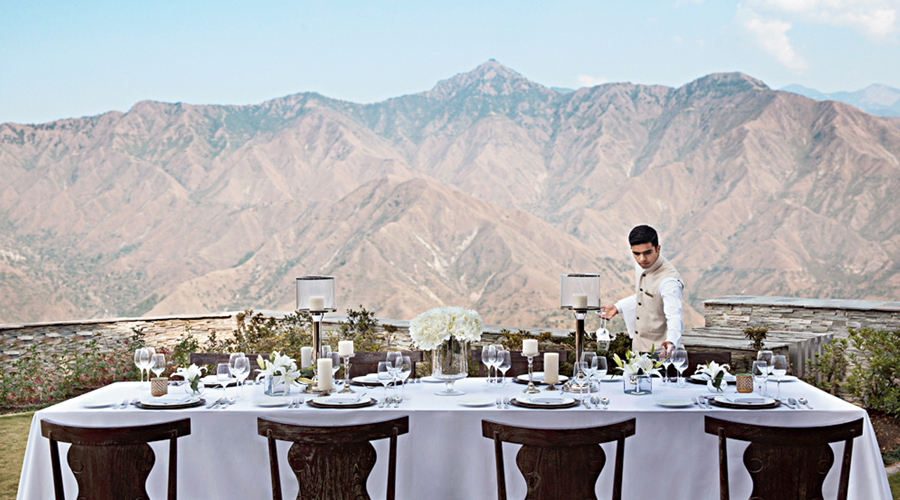
The backdrop to JW Mussoorie's outdoor dining is romantic Zen
The hotels had already acclimatised to the #newnormal of smaller and intimate weddings last year in the wake of a pandemic and with the surge in cases as the second Covid wave rampages through India, the writing is on the wall. This is going to be the only normal for the time being. “In times of uncertainty, one must be prepared to get a mixed response for a wedding status quo. A client, in the current state of awareness, needs to have a minimalist vision that captures details of the wedding effectively. We have been witnessing sustainable mandaps, shortened wedding functions. Clients are also buying out destination-focused properties in order to curb travelling from one place to another. From smart new cleaning technology to social distancing to contactless check-ins, guests want to ensure planning is taken care of by one specialist. Times are changing and so is the mindset,” says Sachin Mylavarapu, general manager at The JW Marriott Mussoorie Walnut Grove Resort & Spa.
The picturesque property has come up with Petite Weddings. “We did notice a trend earlier of families booking an entire hotel or resort, which helped them create their own bio-bubble and celebrate with everyone they wanted. Petite Weddings (is) for a more personalised approach to destination weddings with all commitments to clean safety and hygiene protocols in place,” he says.

Bengal Stateroom at ITC Royal Bengal is spread over a whopping 16,400 sq ft
With a lot in our lives being controlled remotely, wedding preparations too have gone virtual. “Owing to physical distancing, we are offering pre-planning and virtual assistance to keep everything on track. The pandemic has also led to the advent of ‘micro-weddings’ with hotels becoming a one-stop shop for all wedding related arrangements,” says Sachin.
ITC Hotels is seeing a “demand for green and sustainable food norms”. “People have also woken up to the fact that any green effort to save the planet ultimately equates to an effort to save ourselves. They have realised that, for us to live better quality lives for longer, we must be more responsible towards ourselves and our environment. The demand for green and sustainable food norms can be seen in the way communities have come together for mutual support during the Covid-19 crisis. ‘Growing local’ and ‘buying local’ are two key concepts which have come to the fore in these difficult times, and they will only continue to grow in popularity as people have sincerely taken to this newfound wellness connection in their lives,” says a spokesperson.
Jewellery
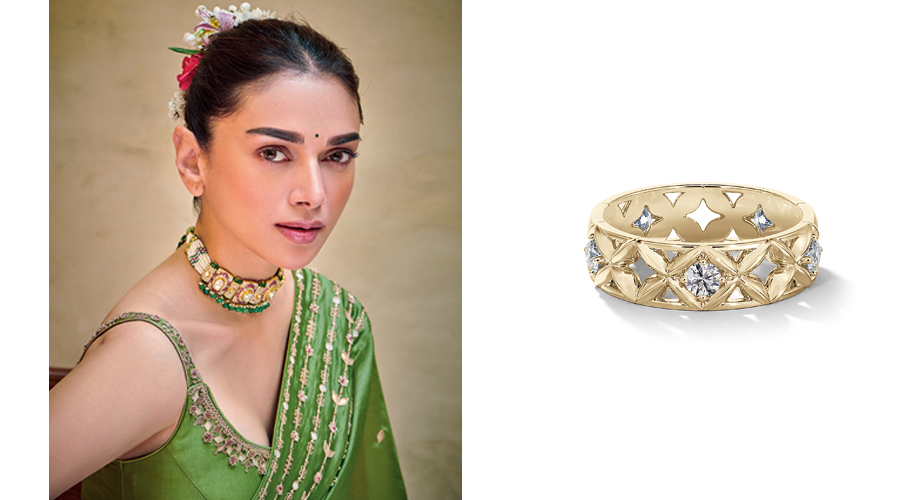
(Left) Aditi Rao Hydari in Punit Balana complemented by a subtle yet striking piece from The House of MBj; (Right) Forevermark Icon collection
The pandemic has brought about “drastic” changes in jewellery “buying trends” feels Abhishek Soni, MD, The House of MBj. “The pre-pandemic trend was based on heavier pieces of jewellery as weddings were huge and massive and the bride had to stand amidst thousands of people whereas the current trend is inclined more towards wearable jewellery with sleeker style, where the jewellery is richer, classier, with exclusive colour stones. The trend of detachable pieces where a big necklace can be worn in many styles has also come up,” he says. At Birdhichand Ghanshyamdas Jewellers too, “there has been a current shift towards minimalistic yet bold and statement jewels”. “We always work towards contemporary designs using traditional techniques. We’ve seen a good swift towards lariats, chokers and statement earrings,” says Team Birdhichand Ghanshyamdas. Diamonds are a girl’s best friend and Federica Imperiali, Forevermark head of new product development feels they “they are timeless, hold meaning, elicit emotions and carry symbolism”. “You can’t go wrong with a tennis bracelet and a beautiful pair of classic diamond stud,” she says.

